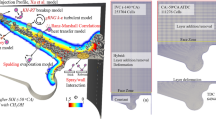Abstract
Current and future engine emission regulations and the imminent need to decarbonize energy systems drive the development of future engine applications, capable of running on renewable fuels with efficient combustion mechanisms. In order to accomplish an optimized performance of future engines, predictive three-dimensional CFD simulations of the phenomena inside the combustion chamber provide a powerful and efficient tool to gain detailed insight into the characteristics of spray formation, mixture and ignition/combustion processes. The presented work demonstrates the application of a developed model implemented into a commercial CFD code to model ignition and combustion for pilot ignited dual fuel engine applications. Validation with experimental data from an optically accessible test rig allows the comparison of the simulation for mixture formation, ignition and combustion behaviour at engine relevant conditions. Excellent agreement between simulation and experiment was found for the application of pilot ignition of natural gas by micro n-dodecane sprays. Furthermore, the demonstration of the simulation of pilot ignition of ammonia is presented to showcase the flexibility of the developed numerical approach wrt. Fuel types, injection and engine parameters for the application in internal combustion engines.
Access this chapter
Tax calculation will be finalised at checkout
Purchases are for personal use only
Similar content being viewed by others
References
Schneider, B., Schürch, C., Boulouchos, K., Herzig, S., Hangartner, M., Humair, D., Wüthrich, S., Gossweiler, C. and Herrmann, K., 2020. The Flex-OeCoS—a novel optically accessible test rig for the investigation of advanced combustion processes under engine-like conditions. Energies, 13(7), p. 1794.
Wüthrich, S., Humair, D., Herrmann, K. and Bertola, A., 2020. Enhanced instrumentation of an optical research engine with unique combustion chamber. ISBN Nummer, pp. 978-3.
Humair, D., Cartier, P., Süess, P., Wüthrich, S., Herrmann, K., Barro, C., Schneider, B., Schürch, C. and Boulouchos, K., 2020, September. Characterization of dual-fuel combustion processes. In Sixth large engine symposium rostock/6. Rostocker Großmotorentagung (pp. 3–4).
Validating Simcenter STAR-CCM+ In-cylinder solution. Siemens Digital Industries Software. [Online]. Available: https://resources.sw.siemens.com/en-US/white-paper-engine-cfd.
Raj, A.G.S., Mallikarjuna, J.M. and Venkitachalam, G., 2013. Analysis of in-cylinder air motion in a DI diesel engine with four different piston bowl configuration-a CFD and PIV comparison. SAE International Journal of Engines, 6(4), pp. 1978–1983.
STAR-ICE – Recommendations on Mesh Resolution. Siemens Digital Industries Software. [Online].
Subramanian, G., Vervisch, L. and Ravet, F., 2007. New developments in turbulent combustion modeling for engine design: ECFM-CLEH combustion submodel (No. 2007-01-0154). SAE Technical Paper.
S. Herzig, “Erfassung des Strömungsfeldes eines Versuchsträgers zur Untersuchung von Brennverfahren mit Hilfe des berührungslosen optischen Messverfahren PIV.”, Masterarbeit FHNW.
Diesel Engine Best Practices 2021.3. Siemens Digital Industries Software. [Online].
Da Cruz, A.P., 2004. Three-dimensional modeling of self-ignition in HCCI and conventional diesel engines. Combustion science and technology, 176(5–6), pp. 867–887.
Simcenter STAR-CCM+ User Guide (2302). Siemens Digital Industries Software.
Smith, G.P., 1999. GRI-Mech 3.0. http://www.me.berkley.edu/gri_mech/.
Visualizing Shocks Using Numerical Schlieren and Shadowgraph. Siemens Digital Industries Software. [Online].
Tinaut, F.V., Reyes, M., Giménez, B. and Pastor, J.V., 2011. Measurements of OH* and CH* chemiluminescence in premixed flames in a constant volume combustion bomb under autoignition conditions. Energy & Fuels, 25(1), pp. 119–129.
Shrestha, K.P., Seidel, L., Zeuch, T. and Mauss, F., 2018. Detailed kinetic mechanism for the oxidation of ammonia including the formation and reduction of nitrogen oxides. Energy & fuels, 32(10), pp. 10202–10217.
Wüthrich, S., Albrecht, P., Cartier, P. and Herrmann, K., 2022. Comparison of pilot fuel ignited premixed ammonia versus methane dual-fuel combustion. In Seventh large engine symposium rostock/7. Rostocker Großmotorentagung.
Acknowledgments
The presented work was conducted in the scope of the research project CREDO (Carbon REduced Dual-fuel cOmbustion), with financial support from the Swiss Federal Office of Energy (BFE) and WinGD. We would like to extend our gratitude also to Jan Hegi (Masterthesis student at combustion and flow solutions GmbH at the time) and our project partners at the University of Applied Sciences and Arts Northwestern Switzerland (FHNW) School of Engineering Institute of Thermal and Fluid Engineering (ITFE) who conducted all the experiments on the test rig and provided all crucial data needed.
Author information
Authors and Affiliations
Corresponding author
Editor information
Editors and Affiliations
Rights and permissions
Copyright information
© 2023 Der/die Autor(en), exklusiv lizenziert an Springer Fachmedien Wiesbaden GmbH, ein Teil von Springer Nature
About this paper
Cite this paper
Schlatter, S., Lämmle, C. (2023). Pilot Ignition in Future Fuels in Engine Systems. In: Kulzer, A.C., Reuss, HC., Wagner, A. (eds) 23. Internationales Stuttgarter Symposium. ISSYM 2023. Proceedings. Springer Vieweg, Wiesbaden. https://doi.org/10.1007/978-3-658-42048-2_25
Download citation
DOI: https://doi.org/10.1007/978-3-658-42048-2_25
Published:
Publisher Name: Springer Vieweg, Wiesbaden
Print ISBN: 978-3-658-42047-5
Online ISBN: 978-3-658-42048-2
eBook Packages: Computer Science and Engineering (German Language)




